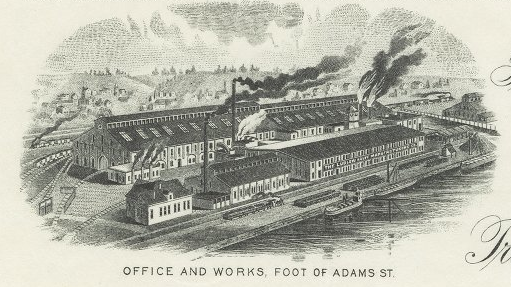
Another beautiful letterhead from the Biggert Collection, this one from the Ludlow Valve Manufacturing Co. of Troy. The Biggert Collection actually has three pieces of correspondence between Jason H. Caldwell, Vice President of Ludlow Valve, and Mr. Eugene Carroll, Superintendent of the Butte Water Company of Butte, Montana. Ordering pipe and valves by correspondence was, apparently, a tedious process.
“We received yesterday your blue print of August 23rd, 1900, showing the size of hub wanted on the 26″ Check Valve for wood pipe, also the drilling of the 24″ Flange Hydraulic Lift Valve. On looking over this drilling we find that the bolt holes come so close to the metal in the body of the valve back of the flange, that you will be unable to use bolts and nuts and stud bolts will have to be used. The valve which we propose furnishing on this order is from our List #5 1/2, and the standard flange for same is 34″, while the flange you call for is only 31 1/4″ in diameter. We, of course, can make up the valve in accordance with your wishes, but thought best to call your attention to this matter before going ahead and getting out the body of the valve, as perhaps you do not care to use stud bolts. We enclose you a sketch showing just how the bolt holes will come, which will explain the matter more fully.” A nice way to ask if you’re sure that’s what you want.
It took a bit of time and some more questions, but on Nov. 21st Mr. Caldwell sent this missive:
“”We are happy to inform you (which we have done by wire to-day) that your complete order goes forward to-day, and that we have requested shipment traced to destination. We trust it will reach you without any delay.”

Ludlow Valve’s office and works were at the foot of Adams Street in Troy. They had another plant in Cohoes. The operations closed abruptly in 1960, putting 500 people out of work. As far as I can see, nothing remains of the old factory.
RPI holds a collection of the papers of Ludlow Valve, and offers a brief history:
The Ludlow Valve Manufacturing Company was founded by Henry Ludlow in
1861. Ludlow, a native of Nassau, NY, had graduated with an engineering
degree from Union College in 1843. He started the company in Waterford,
NY but it quickly grew and Ludlow moved it first to Lansingburgh, NY,
in 1872, and then to Troy, NY in 1897. When the company moved to Troy it
took over the facilities of the Rensselaer Iron Company (Rensselaer
Iron and Steel Company) located on the Poestenkill River in South Troy.Ludlow Valve Manufacturing Company was locally managed by four presidents
until the 1930s. The first president was Henry Ludlow and he remained in
the position until the early 1890s when he was succeeded by John
Christie. At this time, Ludlow sold his interests in the company to a
group of investors from New York City. The company was one of the
largest valve manufacturers in the country and had continued success
under Christie and his nephew James H. Caldwell.James H. Caldwell graduated from Rensselaer Polytechnic Institute in 1886 and
joined the Ludlow Valve Manufacturing Company in 1888. In 1892 he was
elected vice president, in 1893 he became general manager and in 1909 he
took over the role of president for the company. During his presidency,
Ludlow Valve Manufacturing Company was the largest valve and fire
hydrant manufacturer in the country and perhaps the largest in the
world. Interestingly enough, Caldwell was also Vice President of
Rensselaer Polytechnic Institute and his daughter was married to
Livingston W. Houston, future president of both the Ludlow Valve
Manufacturing Company and Rensselaer Polytechnic Institute.Caldwell retired as president from Ludlow in the late 1920’s and
evidence exists that a man named William H. Lolley succeeded him. Lolley
was president of Ludlow during crucial years in the early 1930’s when
serious investigation was taking place regarding the current and future
of the company. When Lolley left (mid 1930’s), Livingston Houston took
over as president of Ludlow. Houston, using Lolly’s recommendations,
introduced a series of changes designed to make Ludlow as prominent as
it had once been. Houston did not remain president for long, leaving the
company in 1935 for a position at RPI. However, he did remain involved
in the company as a board member for many more years.Despite efforts by the Board of Directors, a series of ineffective presidents plagued the business for many years.
A merger with Rensselaer Valve Company was one more effort to revive
From the historical note, RPI Institute Archives and Special Collections, Ludlow Valve Manufacturing Company
Ludlow Valve Manufacturing Company in 1954. It was hoped that Ludlow
could reduce employees, gain strong management and consolidate assets
through this merger. However, physical dismantling of Rensselaer Valve
Company was lengthy and expensive. In the early 1960s, all the problems
faced by Ludlow-Rensselaer Valve Company came to a head. Foreclosure
proceedings were brought against the company by James Talcott and
Company, a primary lender. Future attempts at reorganization were for
naught, and in 1969 final dismantling was initiated. Ludlow valves are
still manufactured today under the Patterson Pump Company name in
Georgia.

Leave a Reply